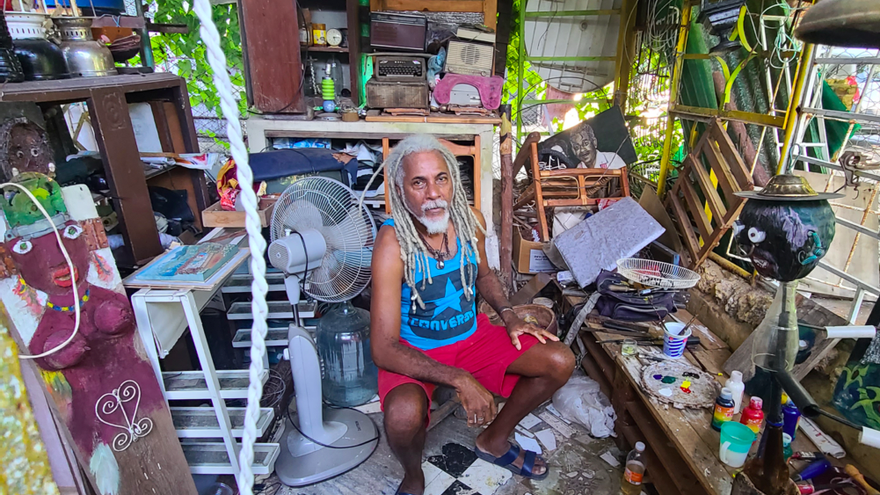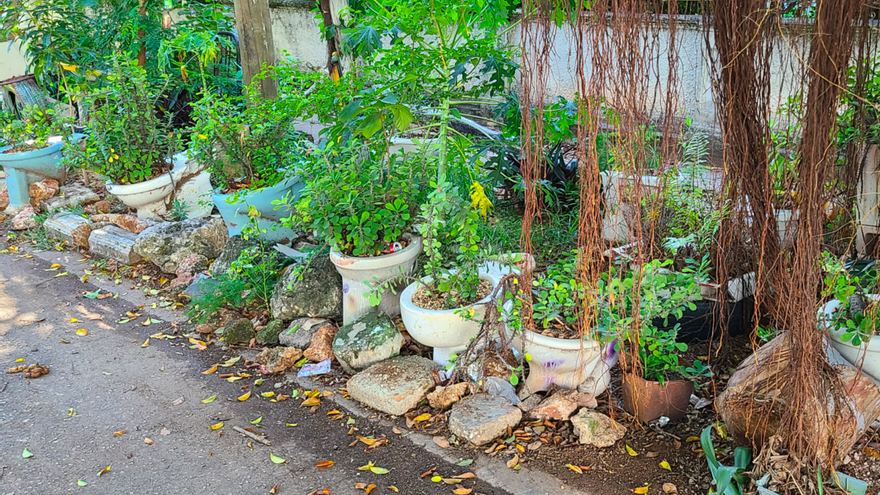
![]() 14ymedio, Nelson García/Juan Izquierdo, Havana, 26 October 2023 — William Agüero is sitting in the center of his workshop, which is also his world. The mess is noticeable. Masks, fans, a typewriter, tubes of oil paint, paint brushes, an old Philco refrigerator, skeletons of Soviet radios, and objects impossible to classify. If they call him an artist it is by chance; he prefers another definition: daring.
14ymedio, Nelson García/Juan Izquierdo, Havana, 26 October 2023 — William Agüero is sitting in the center of his workshop, which is also his world. The mess is noticeable. Masks, fans, a typewriter, tubes of oil paint, paint brushes, an old Philco refrigerator, skeletons of Soviet radios, and objects impossible to classify. If they call him an artist it is by chance; he prefers another definition: daring.
He has a certain Rastafarian air about him, is dressed in a blue T-shirt, and likes to chat. If rum is involved, so much the better. Some time ago, Agüero discovered that the true calling within his work was to avoid any confinement and go out in the open air. He started at home: 21st Street, between 8th and 10th, in Havana’s El Vedado district.
Even if they don’t know Agüero, everyone has visited his world: big open eyes on poles and trees, discs that turn into shiny scales, faces on burnt logs, toilets in which all kinds of plants grow. “In my head I have many more things,” he warns.
Agüero’s creative power does not rest. If he had money, more paint and materials, he would have already expanded his work throughout Havana. A city in ruins, where garbage dumps seem to have a life of their own, is the ideal terrain for his objective: to transform what everyone considers useless into art.
“I started out playing around,” he told 14ymedio. “I used to make shoes, but a painter friend of mine, by the last name of Miruelo, who died recently, asked me to sell some paintings. I knew a lot of people and I sold them all, except one.” That was enough to unleash the world that, according to Agüero, he carried hidden within.

When he had that revelation, his wife was hospitalized, so art was also a remedy to relieve the tension of those days. He began painting “his way,” but continued to sell the work of others – vinyl records of “some young guys, who are very good painters” – until he decided to make his first “masks.”
“I liked it and immersed myself in that world,” he recalls now. He bought canvases and some materials. He also saw some toilet bowls in the trash and said, “Let’s give them a use.” So it has been with all sorts of “tarecos,” or “pieces of junk,” as he calls the artifacts he has rescued from the garbage dump. He has become almost famous, he explains, and his work has been on television.
However, and despite the fact that many fellow painters have invited him to exhibit his work in various galleries, he has never received state aid. “I have done everything with my own resources and efforts,” he says proudly. If anything, friends and admirers stop by his studio and leave him “a little something over there,” which he later transforms into art.
“I eliminate garbage,” Agüero points out. “If it weren’t for this project, the garbage dump at the corner of my neighborhood would be reaching my house by now. One day they pick it up, and then they don’t come for a while.” Recycling is his counterattack and his way of showing his community that, despite Cuba’s unacceptable conditions, life doesn’t have to be depressing.
Of course, some have called him crazy or worse. The project has had its detractors. “But the vast majority,” he says with satisfaction, “is very pleased with what I’ve done in the neighborhood. There are those who are annoyed by it. What can we do? Criticism exists everywhere,” he says. The best part of the work is when the children come. Where others see only trash, they – like the artist – are able to see fantastic cars or imaginary motorcycles.
He is willing to do more, much more, but everything has “its economic part,” he reasons. “Everything is expensive, especially paint, and it’s difficult. Nevertheless, visitors from all over the world continue to pass through the neighborhood. People who explore the other Havana, the one that does not appear in the tourist guides, and discover the magical “tarecos” of Agüero.

Translated by Allison Reyes as part of University of Miami/Spanish 321
____________
COLLABORATE WITH OUR WORK: The 14ymedio team is committed to practicing serious journalism that reflects Cuba’s reality in all its depth. Thank you for joining us on this long journey. We invite you to continue supporting us by becoming a member of 14ymedio now. Together we can continue transforming journalism in Cuba.
